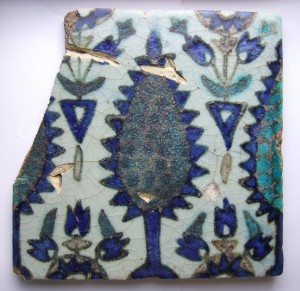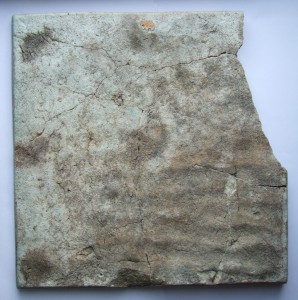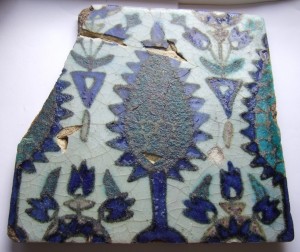Even though our cottage and garden are both pretty small, all in all we have eight neighbours with whom we share a boundary—but the reason for that is for another day’s post (hint: medieval burgages and later coaching inns). There is a low stone wall between us and one of our neighbours’ houses.

The mystery tile. The old breaks are a dirty dark grey; the modern ones bright greyish white. I don’t think it’s Iznik – Indian, maybe?
One day, many years ago, I noticed a lovely old tile sitting on top of the wall—one edge was broken and missing, and the glaze was dinked in a couple of places, but generally it wasn’t in too bad condition. What really grabbed me about it were the colours, turquoises and cobalt blues, and they reminded me of the colours of the Iznik tiles I had seen on the walls in the various ancient mosques I had visited in the Middle East. I didn’t think much more about it. Our neighbour’s kids used to play on the wall and I assumed they had put it there. The next time I saw it was about a year later. It had fallen to the ground on our side of the garden and had broken into about six pieces. I mentioned it to our neighbour and she said ‘Oh that old thing, I don’t want it, chuck it away.’
Well, being a lover of old things and an inveterate hoarder, I could do no such thing. I gathered up all the fragments I could find, washed them, and stuck them back together with HMG glue (beloved of archaeological finds officers across the nation). A few pieces were missing and despite a thorough search I never found them.
I would love to know more about the tile. It measures about 220 mm (8 3/4 inches) square and about 16 mm (7/10 inch) thick, with slightly bevelled edges. The clay from which it is made is a greyish white in colour. There are fingerprints on the backside—you can run your four fingers down where the tile maker smoothed out the clay into the mould. The glaze is very glassy/vitreous. I don’t think it is an Iznik tile as all the ones I have seen have flowing, curving, sinuous plants and foliage, whereas the ones on this tile are quite geometric and angular. I wonder if it might be Indian?

The back of the tile, with the four parallel finger marks running horizontally across from the bottom right corner, from when the maker was smearing and pressing down the clay into the square mould. The darker grey circular marks (there would originally have been nine of them) are presumably something to do with the loading of the tiles in the kiln for firing. Anyhow—if anyone has any ideas about the identification of this tile, I’d love to know.
